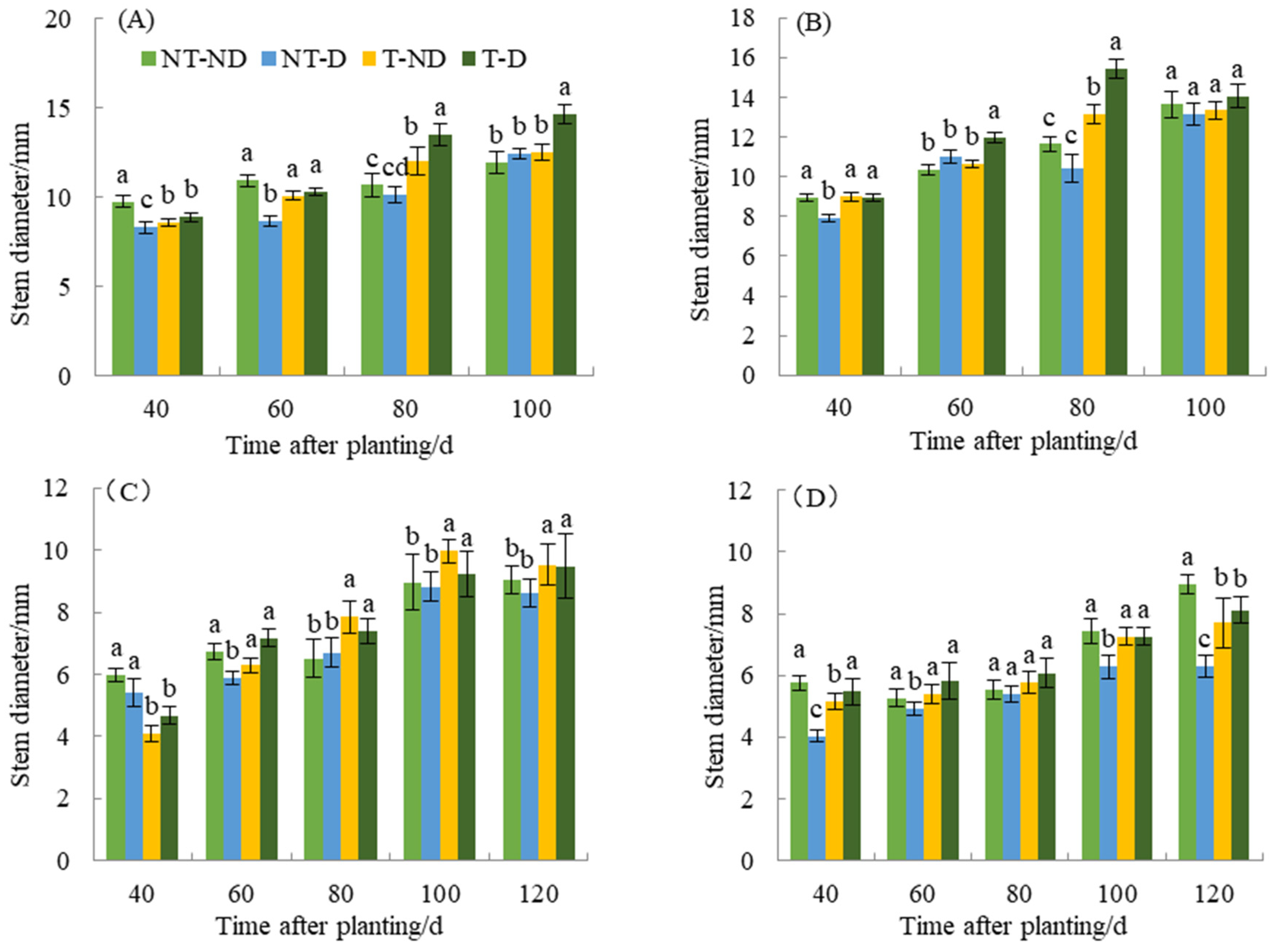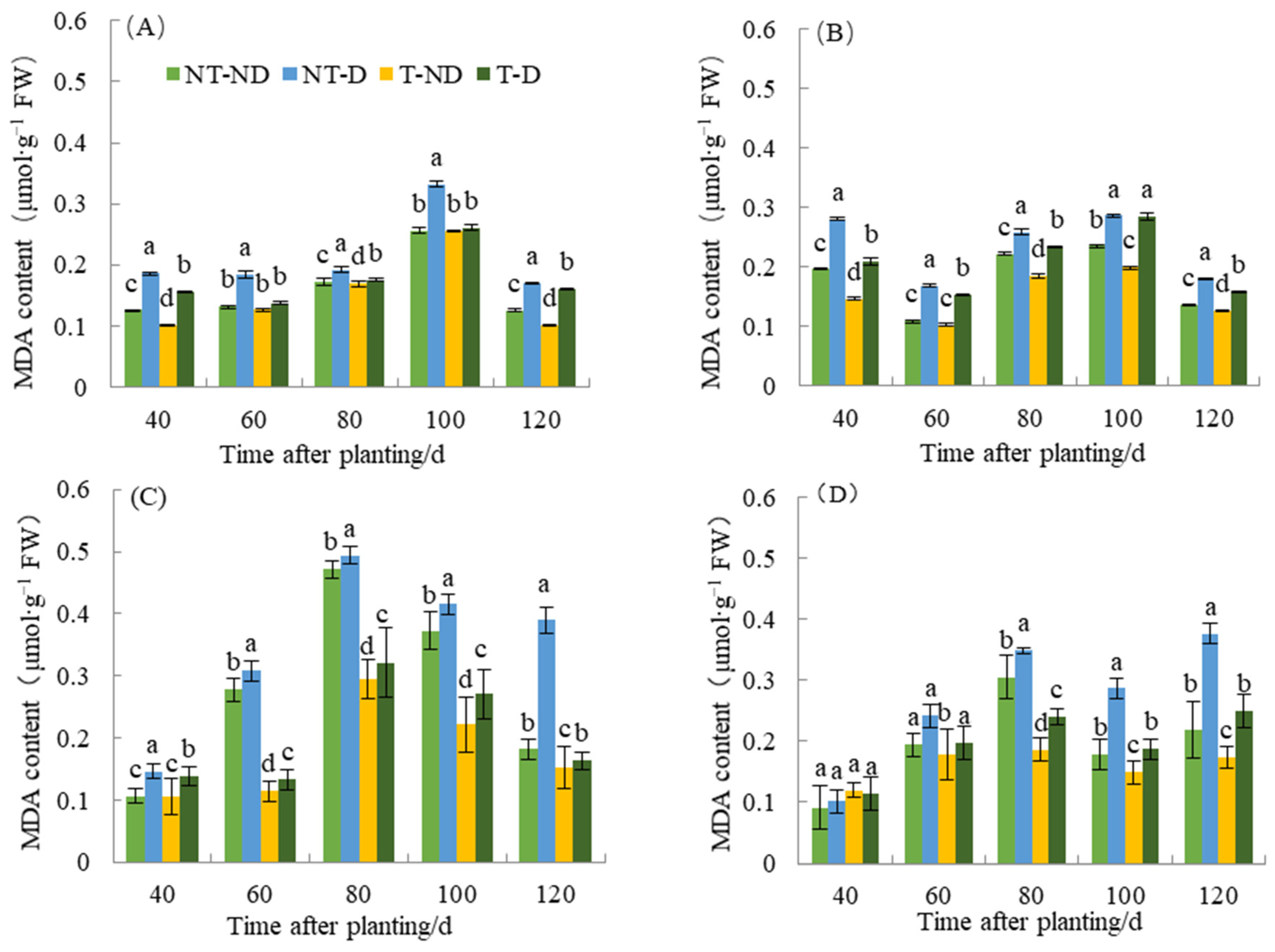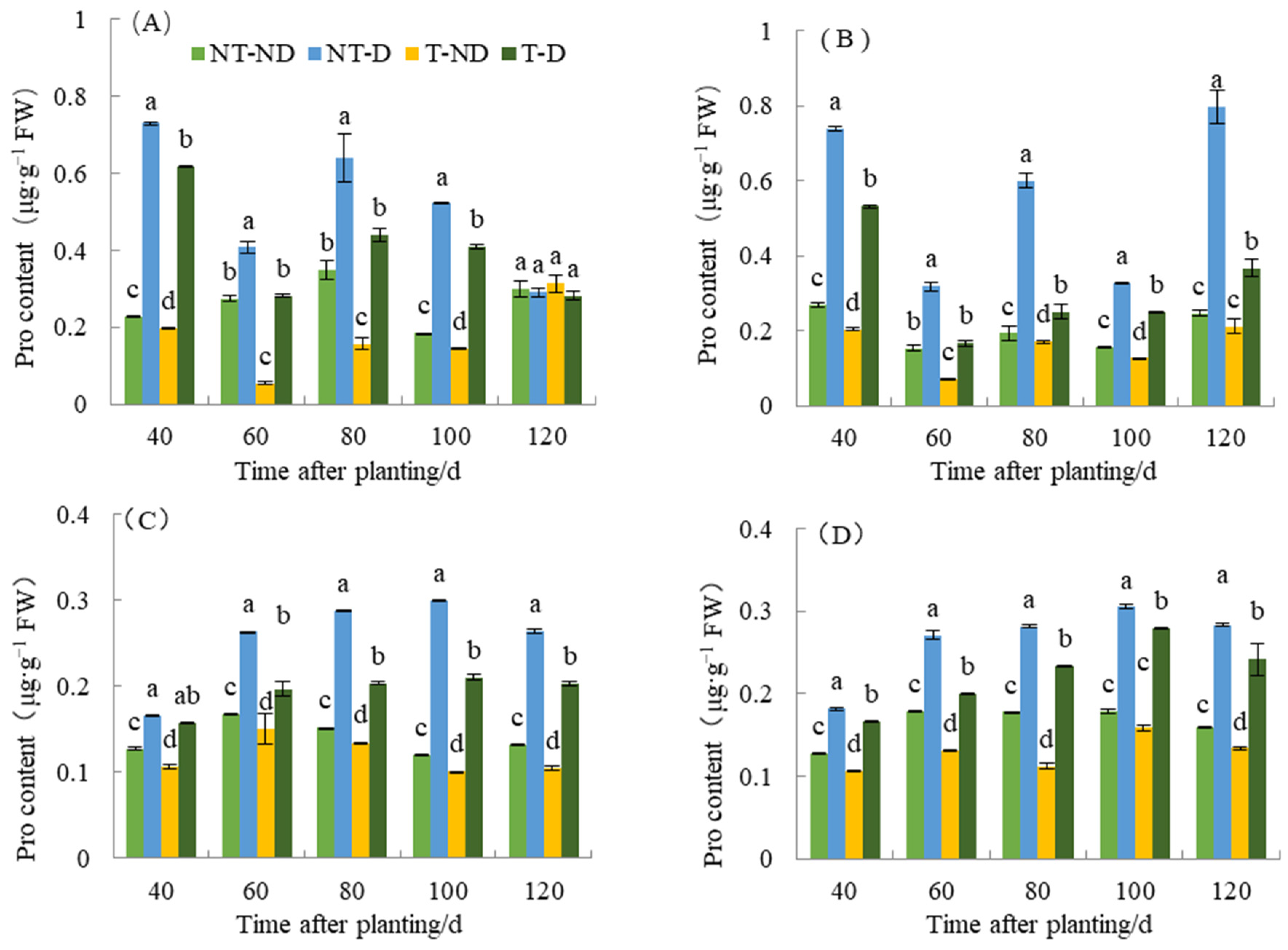Thiamethoxam Application Improves Yield and Drought Resistance of Potatoes (Solanum tuberosum L.)
Abstract
1. Introduction
2. Results
2.1. Effect of Thiamethoxam on Plant Height of Potatoes in Different Treatments
2.2. Effect of Thiamethoxam on Potato Stem Thickness under Different Treatments
2.3. Effect of Thiamethoxam on Root Length of Potato under Different Treatments
2.4. Effect of Thiamethoxam on Relative Chlorophyll Content in Potatoes
2.5. Effect of Thiamethoxam on MDA Content in Potatoes
2.6. Effect of Thiamethoxam on Potato Pro Content
2.7. Effect of Thiamethoxam on SOD Content in Potatoes
2.8. Effect of Thiamethoxam Priming on Potato Yield Per Plant
2.9. Comprehensive Factor Analysis of Potato Drought Resistance Indexes under Different Treatments
3. Discussion
4. Materials and Methods
4.1. Experimental Site and Materials
4.2. Experimental Design and Treatments
4.3. Methods of Data Measurements
4.3.1. Determination of Plant Height, Stem Thickness and Yield
4.3.2. Determination of Relative Chlorophyll Content (SPAD Value)
4.3.3. Determination of Malondialdehyde (MDA) and Proline (Pro) Content
4.3.4. Determination of Enzyme Activity of Superoxide Dismutase (SOD)
4.3.5. Determination of Yield Per Plant
4.4. Analysis of the Data
5. Conclusions
Author Contributions
Funding
Data Availability Statement
Acknowledgments
Conflicts of Interest
References
- Birch, P.R.J.; Bryan, G.; Fenton, B.; Gilroy, E.M.; Hein, I.; Jones, J.T.; Prashar, A.; Taylor, M.A.; Torrance, L.; Toth, I.K. Crops that feed the world 8: Potato: Are the trends of increased global production sustainable? Food Secur. 2012, 4, 477–508. [Google Scholar] [CrossRef]
- Haverkort, A.J.; Linnemann, A.R.; Struik, P.C.; Wiskerke, J.S.C. On Processing Potato. 4. Survey of the Nutritional and Sensory Value of Products and Dishes. Potato Res. 2023, 66, 429–468. [Google Scholar] [CrossRef]
- Khalid, Z.; Humayoun, A.M. Potato Production, Usage, and Nutrition—A Review. Crit. Rev. Food Sci. Nutr. 2016, 56, 711–721. [Google Scholar] [CrossRef]
- Scott, G.J.; Suarez, V.J.J.O.I.; Jite, T.E. The rise of Asia as the centre of global potato production and some implications for industry. Potato J. 2012, 167, 72–76. [Google Scholar] [CrossRef]
- Lu, X.P. Strategy of Potato as Staple Food: Significance, Bottlenecks and Policy Suggestions. J. Huazhong Agric. Univ. (Soc. Sci. Ed.) 2015, 117, 1–7. [Google Scholar] [CrossRef]
- Qi, Y.; Zhao, H.; Lei, J.; Wang, L.J.; Lu, Y.L.; Zhao, F.N.; Yang, Y.; Chen, F. Response of potato yield to climate change insemi-arid region of the Loess Plateau. Agric. Res. Arid Areas 2023, 41, 193–200+220. [Google Scholar] [CrossRef]
- Gervais, T.; Creelman, A.; Li, X.-Q.; Bizimungu, B.; De Koeyer, D.; Dahal, K. Potato Response to Drought Stress Physiological and Growth Basis. Front. Plant Sci. 2021, 12, 698060. [Google Scholar] [CrossRef] [PubMed]
- Zaki, H.E.M.; Radwan, K.S.A. Response of potato (Solanum tuberosum L.) cultivars to drought stress under in vitro and field conditions. Chem. Biol. Technol. Agric. 2022, 9, 1. [Google Scholar] [CrossRef]
- Rudack, K.; Seddig, S.; Sprenger, H.; Köhl, K.; Uptmoor, R.; Ordon, F. Drought stress-induced changes in starch yield and physiological traits in potato. J. Agron. Crop Sci. 2017, 203, 494–505. [Google Scholar] [CrossRef]
- Deblonde, P.M.K.; Ledent, J.F. Effects of moderate drought conditions on green leaf number, stem height, leaf length and tuber yield of potato cultivars. Eur. J. Agron. 2001, 14, 31–41. [Google Scholar] [CrossRef]
- Rozentsvet, O.A.; Bogdanova, E.S.; Nesterov, V.N.; Shevchenko, S.N.; Bakunov, A.L.; Milekhin, A.V.; Rubtsov, S.L. Productivity and Dynamics of Morphological, Physiological, and Biochemical Parameters of Potatoes in Arid Climate. Dokl. Biol. Sci. 2021, 497, 65–68. [Google Scholar] [CrossRef]
- Zhang, M.S.; Tan, F.; Zhang, Q.T.; Yang, Y.H. Physiological indices and selection of methods on rapid identification for sweet potato drought resistance. Agric. Sci. China 2005, 4, 826–832. Available online: https://europepmc.org/article/CBA/599744 (accessed on 4 June 2023).
- Wishart, J.; George, T.S.; Brown, L.K.; White, P.J.; Ramsay, G.; Jones, H.; Gregory, P.J. Field phenotyping of potato to assess root and shoot characteristics associated with drought tolerance. Plant Soil. 2014, 378, 351–363. [Google Scholar] [CrossRef]
- Mthembu, S.G.; Magwaza, L.S.; Mashilo, J.; Mditshwa, A.; Odindo, A. Drought tolerance assessment of potato (Solanum tuberosum L.) genotypes at different growth stages, based on morphological and physiological traits. Agric. Water Manag. 2022, 261, 107361. [Google Scholar] [CrossRef]
- Rolando, J.L.; Ramírez, D.A.; Yactayo, W.; Monneveux, P.; Quiroz, R. Leaf greenness as a drought tolerance related trait in potato (Solanum tuberosum L.). Environ. Exp. Bot. 2015, 110, 27–35. [Google Scholar] [CrossRef]
- Siddique, A.; Kandpal, G.; Kumar, P. Proline Accumulation and its Defensive Role Under Diverse Stress Condition in Plants: An Overview. J. Pure Appl. Microbiol. 2018, 12, 1655–1659. [Google Scholar] [CrossRef]
- Assady, M.; Farahnak, A.; Golestani, A.; Esharghian, M.R. Superoxide Dismutase (SOD) Enzyme Activity Assay in Fasciola spp. Parasites and Liver Tissue Extract. Iran. J. Parasitol. 2011, 6, 17–22. Available online: https://ijpa.tums.ac.ir/index.php/ijpa/article/view/200 (accessed on 5 July 2023). [PubMed]
- Kebede, B.Z.; Firew, M.; Tesfaye, A.; Asrat, A. Drought Resistance Indices for Screening of Potato (Solanum tuberosum L.) Genotypes. Turk. J. Agric.-Food Sci. Technol. 2019, 7, 1118. [Google Scholar]
- Abou El-Yazied, A.; Ibrahim, M.F.M.; Ibrahim, M.A.R.; Nasef, I.N.; Al-Qahtani, S.M.; Al-Harbi, N.A.; Alzuaibr, F.M.; Alaklabi, A.; Dessoky, E.S.; Alabdallah, N.M.; et al. Melatonin Mitigates Drought Induced Oxidative Stress in Potato Plants through Modulation of Osmolytes, Sugar Metabolism, ABA Homeostasis and Antioxidant Enzymes. Plants 2022, 11, 1151. [Google Scholar] [CrossRef]
- Maienfisch, P.; Huerlimann, H.; Rindlisbacher, A.; Gsell, L.; Dettwiler, H.; Haettenschwiler, J.; Sieger, E.; Walti, M. The discovery of thiamethoxam: A second-generation neonicotinoid. Pest Manag. Sci. 2001, 57, 165–176. [Google Scholar] [CrossRef]
- Georgieva, M.; Tsenov, B.; Dimitrova, A. Dual effects of N-nitroguanidine neonicotinoids on plants. Genet. Plant Physiol. 2017, 7, 107–120. Available online: https://www.researchgate.net/publication/322245502 (accessed on 14 September 2023).
- Almeida, A.D.S.; Carvalho, I.; Deuner, C.; Tillmann, M.â.A.; Villela, F.A. Bioativador no desempenho fisiológico de sementes de arroz. Rev. Bras. Sementes 2011, 33, 501–510. [Google Scholar] [CrossRef][Green Version]
- Almeida, A.D.S.; Deuner, C.; Borges, C.T.; Jauer, A.; Meneghello, G.E.; Tunes, L.M.D.; Villela, F.A.; Zimmer, P.D. Physiological Performance of Rice Seeds Treated to Thiamethoxam and Placed under Storage. Am. J. Plant Sci. 2014, 5, 3788–3795. [Google Scholar] [CrossRef][Green Version]
- Larsen, R.J.; Falk, D.E. Effects of a seed treatment with a neonicotinoid insecticide on germination and freezing tolerance of spring wheat seedlings. Can. J. Plant Sci. 2013, 93, 535–540. [Google Scholar] [CrossRef]
- Macedo, W.R.; Castro, P.R.D.C.E. Thiamethoxam: Molecule moderator of growth, metabolism and production of spring wheat. Pestic. Biochem. Physiol. 2011, 100, 299–304. [Google Scholar] [CrossRef]
- Horii, A.; McCue, P.; Shetty, K. Enhancement of seed vigour following insecticide and phenolic elicitor treatment. Bioresour. Technol. 2006, 98, 623–632. [Google Scholar] [CrossRef] [PubMed]
- Tang, T.; Liu, X.; Wang, P.; Fu, W.; Ma, M. Thiamethoxam seed treatment for control of rice thrips (Chloethrips oryzae) and its effects on the growth and yield of rice (Oryza sativa). Crop Prot. 2017, 98, 136–142. [Google Scholar] [CrossRef]
- Zhang, S.; Xiang, D.; Li, H.; Liu, Q. Responses of Root Growth and Morphological Characteristics of Sweet Potato Plants to Varying Nitrogen Levels under Drought. Int. J. Agric. Biol. 2020, 24, 201–206. [Google Scholar]
- Li, L.; Zhou, X.; Yuan, J.; Cheng, L.; Guo, R.; Zhang, F. Analysis of Plant Architecture Factors of Potato. J. Nucl. Agric. Sci. 2023, 9, 1764–1774. [Google Scholar]
- Enkhbold, B.; Ninjmaa, O.; Nyamgerel, K.h. Results of potato varietieis for drought tolerance in vitro conditoin. Mong. J. Agric. Sci. 2018, 22, 72–76. [Google Scholar] [CrossRef]
- Huang, L.; Zhao, C.L.; Huang, F.; Bai, R.E.; Lu, Y.B.; Yan, F.M.; Hao, Z.P. Effects of imidacloprid and thiamethoxam as seed treatments on the early seedling characteristics and aphid-resistance of oilseed rape. J. Integr. Agric. 2015, 14, 2581–2589. [Google Scholar] [CrossRef]
- Lauxen, L.R.; Almeida, A.D.S.; Deuner, C.; Meneghello, G.E.; Villela, F.A. Physiological response of cotton seeds treated with thiamethoxam under heat stress. J. Seed Sci. 2019, 38, 140–147. [Google Scholar] [CrossRef]
- Sahin, U.; Ekinci, M.; Ors, S.; Turan, M.; Yildiz, S.; Yildirim, E. Effects of individual and combined effects of salinity and drought on physiological, nutritional and biochemical properties of cabbage (Brassica oleracea var. capitata). Sci. Hortic. 2018, 240, 196–204. [Google Scholar] [CrossRef]
- Hasan, A.; Hafiz, H.R.; Siddiqui, N.; Khatun, M.; Islam, R.; Mamun, A.-A. Evaluation of wheat genotypes for salt tolerance based on some physiological traits. J. Crop Sci. Biotechnol. 2015, 18, 333–340. [Google Scholar] [CrossRef]
- Killi, D.; Raschi, A.; Bussotti, F. Lipid Peroxidation and Chlorophyll Fluorescence of Photosystem II Performance during Drought and Heat Stress is Associated with the Antioxidant Capacities of C3 Sunflower and C4 Maize Varieties. Int. J. Mol. Sci. 2020, 21, 4846. [Google Scholar] [CrossRef]
- Zhang, Y.; Luan, Q.; Jiang, J.; Li, Y. Prediction and Utilization of Malondialdehyde in Exotic Pine Under Drought Stress Using Near-Infrared Spectroscopy. Front. Plant Sci. 2021, 12, 735275. [Google Scholar] [CrossRef]
- Zhang, C.; Shi, S.; Liu, Z.; Yang, F.; Yin, G. Drought tolerance in alfalfa (Medicago sativa L.) varieties is associated with enhanced antioxidative protection and declined lipid peroxidation. J. Plant Physiol. 2019, 232, 226–240. [Google Scholar] [CrossRef]
- Tirani, M.M.; Haghjou, M.M. Reactive oxygen species (ROS), total antioxidant capacity (AOC) and malondialdehyde (MDA) make a triangle in evaluation of zinc stress extension. J. Anim. Plant Sci. 2019, 29, 1100–1111. Available online: https://www.researchgate.net/publication/330981127 (accessed on 2 January 2024).
- Ahmadipour, S.; Arji, I.; Ebadi, A.; Abdossi, V. Physiological and biochemical responses of some olive cultivars (Olea europaea L.) to water stress. Cell. Mol. Biol. 2018, 64, 20–29. [Google Scholar] [CrossRef]
- Zouari, M.; Elloumi, N.; Labrousse, P.; Ben Rouina, B.; Ben Abdallah, F.; Ben Ahmed, C. Olive trees response to lead stress: Exogenous proline provided better tolerance than glycine betaine. S. Afr. J. Bot. 2018, 118, 158–165. [Google Scholar] [CrossRef]
- Endres, L.; Oliveira, N.G.; Ferreira, V.M.; Silva, J.V.; Barbosa, G.V.S.; Maia Junior, S.O. Morphological and physiological response of sugarcane under abiotic stress to neonicotinoid insecticides. Theor. Exp. Plant Physiol. 2016, 28, 347–355. [Google Scholar] [CrossRef]
- Signorelli, S.; Borsani, O.; Monza, J. Molecular Mechanisms for the Reaction between ·OH Radicals and Proline: Insights on the Role as Reactive Oxygen Species Scavenger in Plant Stress. J. Phys. Chem. B 2014, 118, 37–47. [Google Scholar] [CrossRef]
- Moreno-Galván, A.E.; Cortés-Patiño, S.; Romero-Perdomo, F.; Uribe-Vélez, D.; Bashan, Y.; Bonilla, R.R. Proline accumulation and glutathione reductase activity induced by drought-tolerant rhizobacteria as potential mechanisms to alleviate drought stress in Guinea grass. Appl. Soil. Ecol. 2020, 147, 103367. [Google Scholar] [CrossRef]
- Mwadzingeni, L.; Shimelis, H.; Tesfay, S.; Tsilo, T.J. Screening of Bread Wheat Genotypes for Drought Tolerance Using Phenotypic and Proline Analyses. Front. Plant Sci. 2016, 7, 1276. [Google Scholar] [CrossRef] [PubMed]
- Raheleh, R.; Ramazanali, K.-N.; Ali, G.; Abdolreza, B.; Farzaneh, N.; Masoud, R. Use of biochemical indices and antioxidant enzymes as a screening technique for drought tolerance in Chickpea genotypes (Cicer arietinum L.). Afr. J. Agric. Res. 2012, 7, 5372–5380. [Google Scholar]
- Hasanuzzaman, M.; Bhuyan, M.B.; Faisal, Z.; Ali, R.; Sayed, M.M.; Jubayer, A.M.; Masayuki, F.; Vasileios, F. Reactive Oxygen Species and Antioxidant Defense in Plants under Abiotic Stress: Revisiting the Crucial Role of a Universal Defense Regulator. Antioxidant 2020, 9, 681. [Google Scholar] [CrossRef] [PubMed]
- Suman, S.; Bagal, D.; Jain, D.; Singh, R.; Singh, I.K.; Singh, A. Chapter 14-Biotic stresses on plants: Reactive oxygen species generation and antioxidant mechanism. In Frontiers in Plant-Soil Interaction; Academic Press: Cambridge, MA, USA, 2021; pp. 381–411. [Google Scholar] [CrossRef]
- Morrissey, C.A.; Mineau, P.; Devries, J.H.; Sanchez-Bayo, F.; Liess, M.; Cavallaro, M.C.; Liber, K. Neonicotinoid contamination of global surface waters and associated risk to aquatic invertebrates: A review. Environ. Int. 2015, 74, 291–303. [Google Scholar] [CrossRef] [PubMed]
- Zhao, Y.; Yang, J.; Ren, J.; Hou, Y.; Li, Y.J.S. Exposure Level of Neonicotinoid Insecticides in the Food Chain and the Evaluation of Their Human Health Impact and Environmental Risk: An Overview. Sustainability 2020, 12, 7523. [Google Scholar] [CrossRef]
- Mesnage, R.; Biserni, M.; Genkova, D.; Wesolowski, L.; Antoniou, M.N. Evaluation of neonicotinoid insecticides for oestrogenic, thyroidogenic and adipogenic activity reveals imidacloprid causes lipid accumulation. J. Appl. Toxicol. 2018, 38, 1483–1491. [Google Scholar] [CrossRef] [PubMed]
- Hallmann, C.A.; Foppen, R.P.B.; Turnhout, C.A.M.V.; Kroon, H.D.; Jongejans, E. Declines in insectivorous birds are associated with high neonicotinoid concentrations. Nature 2014, 511, 341–343. [Google Scholar] [CrossRef] [PubMed]
- Ma, J.; Hao, Y.; Guo, L.Q.; Li, K.; Zhang, J.L.; Xu, W.J.; Gong, X.M.; Customs, W. Research progress on pollution and control of neonicotinoid insecticides in food. J. Food Saf. Qual. 2022, 13, 278–286. [Google Scholar]
- Yang, L.; Yadong, L.; Yiming, L.; Ward, T.J. Photodegradation of clothianidin and thiamethoxam in agricultural soils. Environ. Sci. Pollut. Res. Int. 2018, 25, 31318–31325. [Google Scholar] [CrossRef]
- Zhou, G.; Wang, Y.; Zhai, S.; Ge, F.; Liu, Z.; Dai, Y.; Yuan, S.; Hou, J. Biodegradation of the neonicotinoid insecticide thiamethoxam by the nitrogen-fixing and plant-growth-promoting rhizobacterium Ensifer adhaerens strain TMX-23. Appl. Microbiol. Biotechnol. 2013, 97, 4065–4074. [Google Scholar] [CrossRef] [PubMed]
- Rodríguez-Castillo, G.; Molina-Rodríguez, M.; Cambronero-Heinrichs, J.C.; Quirós-Fournier, J.P.; Lizano-Fallas, V.; Jiménez-Rojas, C.; Masís-Mora, M.; Castro-Gutiérrez, V.; Mata-Araya, I.; Rodríguez-Rodríguez, C.E. Simultaneous removal of neonicotinoid insecticides by a microbial degrading consortium: Detoxification at reactor scale. Chemosphere 2019, 235, 1097–1106. [Google Scholar] [CrossRef] [PubMed]
- Cabello, R.; Mendiburu, F.D.; Bonierbale, M.; Monneveux, P.; Roca, W.; Chujoy, E. Large-Scale Evaluation of Potato Improved Varieties, Genetic Stocks and Landraces for Drought Tolerance. Am. J. Potato Res. 2012, 89, 400–410. [Google Scholar] [CrossRef]
- Kumar, G.; Knowles, N.R. Changes in lipid peroxidation and lipolytic and free-radical scavenging enzyme activities during aging and sprouting of potato (Solanum tuberosum) seed-tubers. Plant Physiol. 1993, 102, 115–124. [Google Scholar] [CrossRef]








| Indictors | PCA 1 | PCA 2 | Weighted Value |
|---|---|---|---|
| Plant height | 0.9547 | 0.0260 | 0.1508 |
| Thick stems | 0.1984 | 0.8658 | 0.0942 |
| Chlorophyll content | 0.5656 | 0.5353 | 0.1273 |
| Malondialdehyde content | 0.8876 | 0.4211 | 0.1692 |
| Proline content | 0.9755 | 0.1959 | 0.1665 |
| Superoxide dismutase content | 0.5239 | 0.8398 | 0.1431 |
| Yield per plant | 0.9461 | 0.0197 | 0.1490 |
| Eigen value | 4.1796 | 1.9581 | |
| Contribution (%) | 59.7096 | 27.9734 | |
| Cumulative (%) | 59.7096 | 87.6831 |
| Indictors | NT–ND | NT–D | T–ND | T–D |
|---|---|---|---|---|
| Plant height | 0.4248 | 0.0000 | 1.0000 | 0.2146 |
| Thick stems | 0.6495 | 0.0000 | 0.3843 | 1.0000 |
| Chlorophyll content | 0.0000 | 0.7664 | 0.5452 | 1.0000 |
| Malondialdehyde content | 0.8624 | 0.0000 | 1.0000 | 0.7248 |
| Proline content | 0.3966 | 1.0000 | 0.0000 | 0.5811 |
| Superoxide dismutase content | 0.0000 | 0.3164 | 0.1258 | 1.0000 |
| Yield per plant | 0.3964 | 0.0000 | 1.0000 | 0.1638 |
| Comprehensive index | 0.3962 | 0.3093 | 0.5926 | 0.6407 |
| Comprehensive ranking | 3 | 4 | 2 | 1 |
| Year | Month | Average Low Temperature/(°C) | Average High Temperature/(°C) | Average Temperature/(°C) | Average Humidity/(g·kg−1) | Rainfall/(mm) |
|---|---|---|---|---|---|---|
| 2018 | May | 10.54 | 25.15 | 19.26 | 34.22 | 39.3 |
| June | 15.11 | 28.26 | 23.35 | 36.92 | 11.4 | |
| July | 17.69 | 28.80 | 23.88 | 26.79 | 97.1 | |
| August | 18.84 | 26.45 | 23.13 | 23.07 | 106.4 | |
| September | 10.24 | 21.00 | 17.18 | 23.81 | 93.6 | |
| 2019 | May | 10.31 | 22.12 | 20.47 | 20.12 | 14.5 |
| June | 15.29 | 26.46 | 22.35 | 30.48 | 66.7 | |
| July | 17.27 | 28.13 | 23.41 | 25.11 | 44.8 | |
| August | 17.13 | 28.49 | 23.72 | 27.19 | 71.6 | |
| September | 13.21 | 24.58 | 19.46 | 28.47 | 52.1 |
| Treatment Number | Treatment Conditions |
|---|---|
| NT–ND | Soil volume water content (θw: 55 ± 5%) was not applied to thiamethoxam, throughout the growing season, and there was no drought stress. |
| NT–D | The soil volume water content (θw: 35 ± 5%) throughout the growing period, without applying thiamethoxam, there was drought stress. |
| T–ND | The soil volume water content (θw: 55 ± 5%) in the whole growing period was coated with thiamethoxam, and there was no drought stress. |
| T–D | The soil volume water content (θw: 35 ± 5%) in the whole growing period, coated with thiamethoxam, there was drought stress. |
Disclaimer/Publisher’s Note: The statements, opinions and data contained in all publications are solely those of the individual author(s) and contributor(s) and not of MDPI and/or the editor(s). MDPI and/or the editor(s) disclaim responsibility for any injury to people or property resulting from any ideas, methods, instructions or products referred to in the content. |
© 2024 by the authors. Licensee MDPI, Basel, Switzerland. This article is an open access article distributed under the terms and conditions of the Creative Commons Attribution (CC BY) license (https://creativecommons.org/licenses/by/4.0/).
Share and Cite
Qiu, H.; Sun, C.; Dormatey, R.; Bai, J.; Bi, Z.; Liu, Y.; Liu, Z.; Wei, J.; Mao, S.; Yao, P. Thiamethoxam Application Improves Yield and Drought Resistance of Potatoes (Solanum tuberosum L.). Plants 2024, 13, 477. https://doi.org/10.3390/plants13040477
Qiu H, Sun C, Dormatey R, Bai J, Bi Z, Liu Y, Liu Z, Wei J, Mao S, Yao P. Thiamethoxam Application Improves Yield and Drought Resistance of Potatoes (Solanum tuberosum L.). Plants. 2024; 13(4):477. https://doi.org/10.3390/plants13040477
Chicago/Turabian StyleQiu, Hailong, Chao Sun, Richard Dormatey, Jiangping Bai, Zhenzhen Bi, Yuhui Liu, Zhen Liu, Jingui Wei, Shoufa Mao, and Panfeng Yao. 2024. "Thiamethoxam Application Improves Yield and Drought Resistance of Potatoes (Solanum tuberosum L.)" Plants 13, no. 4: 477. https://doi.org/10.3390/plants13040477
APA StyleQiu, H., Sun, C., Dormatey, R., Bai, J., Bi, Z., Liu, Y., Liu, Z., Wei, J., Mao, S., & Yao, P. (2024). Thiamethoxam Application Improves Yield and Drought Resistance of Potatoes (Solanum tuberosum L.). Plants, 13(4), 477. https://doi.org/10.3390/plants13040477









